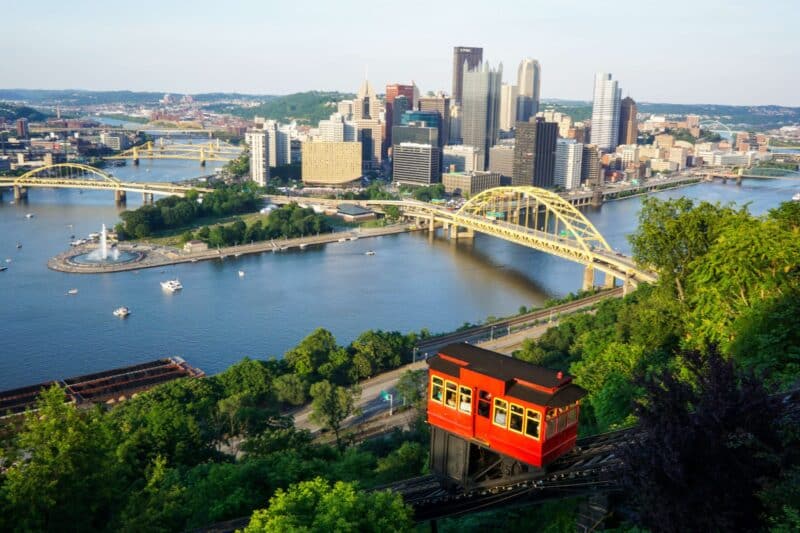Pittsburgh’s 4 Areas to Explore
Click on the colored areas to read more about each Pittsburgh area.

Strip District, PA

Easy to get around, lots to do, melds a younger and older population
Distance from downtown: 4 minutes
Population: 3,214 with 5% of the population over 65 years of age
Places to visit:
-
John Heinz History Center: Named after Senator John Heinz and affiliated with the Smithsonian Institution, there’s something for everyone when taking in over 250 years of regional history through 6 floors of engaging exhibitions. Relive the battles of the French & Indian War. Learn about Pittsburgh’s influence as a steel-making industrial powerhouse and see how its transformed into a global leader for technology, medicine, and education. If you’re looking for a fun photo op, take a selfie next to an 11-foot Heinz ketchup bottle or relive your childhood in the Mr. Roger's neighborhood exhibit.
-
Andy Warhol Museum: Experience art through one of the most comprehensive single-artist museums in the world and the largest in North America. Pittsburgh native and pop art icon, Andy Warhol has a seven-story museum devoted to his life and artistic journey. Start your experience at the top floor and progress through each decade as you descend. View his celebrated illustrations, sculptures, photographs, paintings, and films as you gain a profound understanding of his enduring legacy.
-
St. Stanislaus Kostka Church: Steeped in a history dating back to its construction in 1891, this Romanesque-styled Roman Catholic Church has survived a major flood and explosion, to become a proud piece of Pittsburgh history. It sits 63 feet high, with towers supporting 7 bells, each dedicated to a different Catholic saint, and is adorned with some of the best “Munich Style” stained glass in the United States. Whether you take a tour, or attend a Sunday mass, you’ll appreciate why it’s been added to the National Register of Historic Places and why the future Pope John II was so fond of its beauty during his visit.
Moon Township, PA
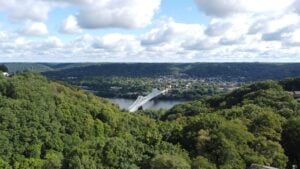
Surrounded by nature, with access to the city and beyond
Distance from downtown: 15.6 miles
Population: 26,863 with 18% of the population over 65 years of age
Places to visit:
- Whether you're looking to play, hike, bike, or explore, Moon Park, Montour Trail, and Robin Hill Park are just some of the parks that combine to offer over 600 acres of land perfect for staying active through all the seasons.
Oakland, Shadyside, and Squirrel Hill, PA
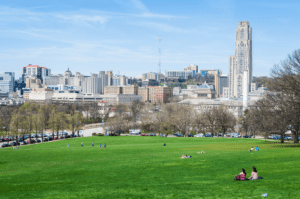
Cultured, laid back, and family-oriented
Distance from downtown: 5 minutes
Places to visit:
- Schenley Park: Named one of “America’s Coolest City Parks” by Travel and Leisure, this 456 winding acre area contains trails, woods, and attractions. Hike or bike the miles of trails, play on one of the 13 tennis courts, run the track, or play 18 holes of golf. Nomatter what you’re looking for, there’s plenty to do for all ages.
- Phipps Conservatory and Botanical Gardens: This green oasis in the middle of Pittsburgh’s Oakland neighborhood has been entertaining visitors since 1893. Visit to discover breathtaking seasonal flower shows, stunning outdoor botanical gardens, and enjoy activities sure to satisfy every age.
Interesting facts:
- Roslyn Place, the last wooden street remaining in Pennsylvania, can be found in the Shadyside neighborhood. Constructed in 1914 with 26,000 wooden blocks, this road is a must-see.
Irwin, PA
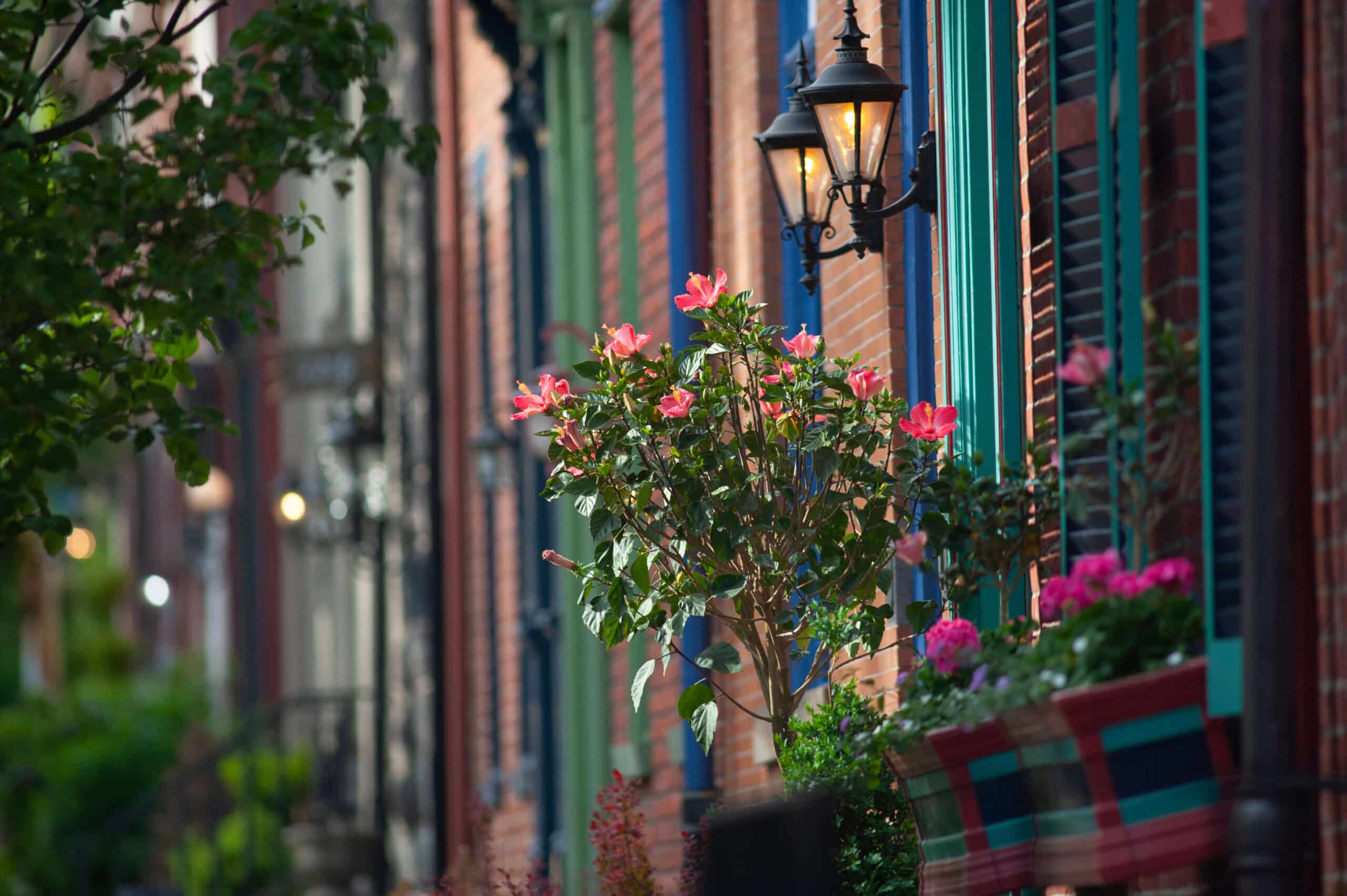
Rural, close-knit community
Distance from downtown: 22 miles
Population: 3,894 with 16.4% of the population over 65 years of age
Places to visit:
-
Brush Hill: This historic “mansion-scale” house, also known as the “Old Scull House '' was constructed by Colonel John Irwin in 1798. One of three plantations owned by the family, its sheer scale and first of its kind west of the Appliacians, caused it to be added to the National Register of Historic Places in 1975.
-
Logan Family Farms: Established in 1894 and widely recognized as the staple of quality meat and produce for four generations, this family farm is a frequent stop for residents and a must stop for visitors.
-
The Lamp Theatre: Tucked in the downtown amongst a variety of restaurants and small shops sits this unique venue that offers live concerts and plays for all ages.
As a financial advisor, retirement planner, and long-time resident of Southwestern Pennsylvania, I’m often asked by people if Pittsburgh is a good place to retire. Without hesitation, I’ll share the many reasons I’m proud to call Pittsburgh home and why I think it’s great for retirees. Pittsburgh is a vibrant city couched in the beauty of the Pennsylvanian landscape, and its low cost of living makes it exceptionally appealing to people on a fixed income. In this article, I discuss why Pittsburgh is a good place to retire and make your permanent home, no matter what your age.
Is Pittsburgh a Good Place to Live?
Before diving into why Pittsburgh is an ideal place to settle down in retirement, I’m going to discuss why Pittsburgh is a good place to live for all ages.
Pittsburgh, PA has always been a city built on innovation. Once an economic powerhouse for American raw materials during the late 19th to mid-20th centuries, these days it has become a center for technology innovation (top schools like Carnegie Mellon University make Pittsburgh an appealing location for tech companies). Google, Duolingo, and up-and-coming tech companies like Gecko Robotics, Petuum, and Seegrid all have offices in Pittsburgh.
Other world-renowned universities like Duquesne University, the University of Pittsburgh, and Robert Morris University are in or near Pittsburgh, and it’s home to two of the biggest healthcare systems in the Midwest. Economically, the Pittsburgh-region is doing quite well, with unemployment going down since June of 2022.
If you’re looking to start a family, the 90 neighborhoods surrounding the city offer unique areas to explore and hidden gems to uncover. In 2022, Dwellics named Pittsburgh the Best City to Raise a Family in the Northeast with quality education, low crime rate, and cost of living, as some of the prime factors highlighted. And it offers some of the best outdoors activities in the region; in recent years, Pittsburgh’s three intersecting rivers (the Ohio River, the Monongahela River, and the Allegheny River) have been developed with more recreational opportunities, and the forests and landscape of southwestern Pennsylvania offer skiing, hiking, biking, camping, hunting, snowmobiling, and other outdoorsy activities that are more accessible than bigger metropolitan areas.
Is Pittsburgh a Good Place to Retire?
Here are 5 reasons why Pittsburgh is a great place to retire.
1. Retirement friendly
In 2021, Pittsburgh ranked number one for attracting relocating retirees. Despite hitting its lowest number in 7 years with only 226,000, there are still more seniors relocating to Pittsburgh than any other city. Relatively low cost of living, no taxes on retirement income, high-quality health care systems, and several prestigious universities for continuing education are cited as just some of the reasons why Pittsburgh has become so appealing to seniors.
Carnegie Mellon University, La Roche University, and University of Pittsburgh are just some of the esteemed Pittsburgh education institutions that offer a variety of classes to enhance interests, encourage lifelong learning, and create opportunities for adults 55+. Seniors have the opportunity to sign up for audit undergraduate courses costing as little as $25.00 a course.
2. Plenty to do with a vibrant cultural scene
Holding the title of second biggest city in Pennsylvania, Pittsburgh doesn’t disappoint when it comes to entertainment options. Check out renowned theaters such as Benedum Center, Heinz Hall, and Kelly Strayhorn Theater. Take your pick of over 20 museums to visit including the Andy Warhol Museum (a must see!) and Carnegie Museum Of Natural History. Then, when you feel the first glimpse of hunger pangs, delve into the tasty and diverse food scene and make sure to sample a Primanti’s sandwich stuffed with enough fries to satisfy a full table.
Are you a sports fan? Take in a Pittsburgh Pirates game at PNC Park or wave your terrible towel while cheering for the Steelers and Heinz Field. Looking for something unique or educational? Stop by the Pittsburgh Zoo and Aquarium to see over 8000 animals from 600 species or catch a glimpse of the Duquesne Incline which offers a beautiful view of the city in all its bridge and skyscraper glory. If you’re just looking for a leisurely stroll to take in one of Pittsburgh’s 4 distinct seasons, explore 2000 acres of land through one of the city’s parks, or plenty of their surrounding county parks, state parks, and riverfront parks.
No matter what you partake in, every experience helps tie you into the strong community Pittsburgh has proudly built over the years.
3. Quality and accessible healthcare
Whether you are looking for your first home or considering where to settle down in your golden years, access to quality healthcare is always one of the top priorities for residents. Being in a larger city like Pittsburgh gives residents of all ages access to a variety of hospital networks and options to highly regarded healthcare professionals.
Pittsburgh is home to several top medical facilities including:
- University of Pittsburgh Medical Center: The busiest transplant center in the world.
- UPMC Presbyterian Shadyside: Ranked as the #2 hospital in the state and named one of the country’s top hospitals in 10 different specialties.
- Children’s Hospital of Pittsburgh: Ranked one of the 10 best in the country for pediatric medicine.
Outside of healthcare quality, it’s important to think about these points when making the decision on where to reside:
- How close are nearby hospitals and ERs?
- What type of specialists do I need to access regularly?
- Are these healthcare systems reputable?
- Is there a good standard of care?
4. Cost of living
Pittsburgh’s cost of living is lower than other major metropolitan areas coming in at 12.5% lower than the national average and 7.5% lower than the state average. Its housing is 35% lower than the national average with a median home value of $116,300. The appeal of an affordable cost of living and housing market attracts many to the area and with over 20 companies headquartered in the Pittsburgh area, a large number of new residents are honing in on its urban core.
For retirees, the added perk of no taxes on retirement income (including Social Security, pensions, IRAs, and 401Ks) helps maximize the savings they’ve worked so hard to accumulate.
5. Green and clean
The steel industry has had a profound impact on the city of Pittsburgh and the proud nickname of “Steel City” still reflects that today. Once a world leader in the production of steel, its accomplishments triggered an innovative and creative identity that residents still follow today.
However, with the collapse of the steel industry, a new era of transformation emerged. Now nicknamed by some as the “Reinvention City”, Pittsburgh has successfully brought cutting-edge companies in fields such as artificial intelligence, robotics, and health sciences to the economical forefront.
Now cleaner, and fuller of energy, Pittsburgh has shifted its reputation from a polluted steel mill town to an educational and tech hub. Home to plenty of forests, mountains, and farmland, it now ranks as one of the “greenest” cities in America and even hosted the G-20 summit in 2009.
The 4 Best Pittsburgh Neighborhoods for Retirees
1. Strip District
Easy to get around, lots to do, melds a younger and older population
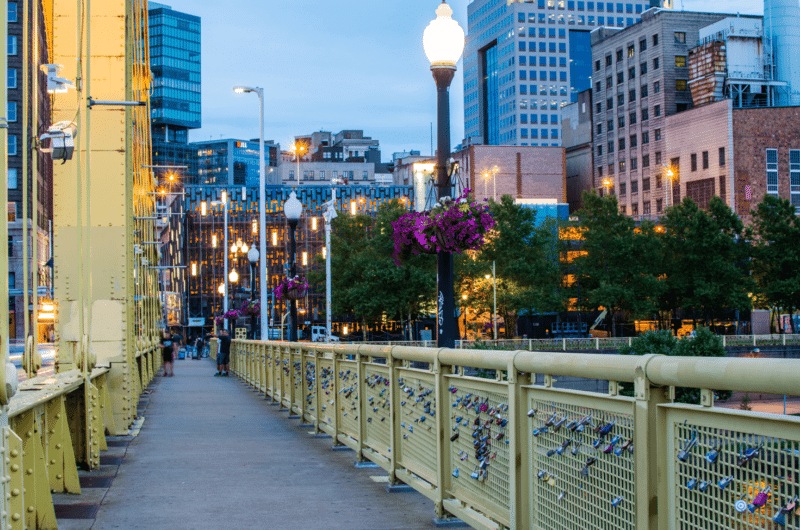
Distance from downtown: 4 minutes
Population: Population: 3,214 with 5% of the population over 65 years of age
Located 7 minutes from downtown Pittsburgh between the banks of the Allegheny River and a railroad, sits the Strip District, a scenic neighborhood stocked full of historic landmarks, delicious ethnic eats, and unique shopping experiences. Its prime location combined with affordable housing attracts young professionals looking for an urban feel and multicultural vibe.
Places to visit:
- John Heinz History Center: Named after Senator John Heinz and affiliated with the Smithsonian Institution, there’s something for everyone when taking in over 250 years of regional history through 6 floors of engaging exhibitions. Relive the battles of the French & Indian War. Learn about Pittsburgh’s influence as a steel-making industrial powerhouse and see how its transformed into a global leader for technology, medicine, and education. If you’re looking for a fun photo op, take a selfie next to an 11-foot Heinz ketchup bottle or relive your childhood in the Mr. Roger’s neighborhood exhibit.
- Andy Warhol Museum Experience art through one of the most comprehensive single-artist museums in the world and the largest in North America. Pittsburgh native and pop art icon, Andy Warhol has a seven-story museum devoted to his life and artistic journey. Start your experience at the top floor and progress through each decade as you descend. View his celebrated illustrations, sculptures, photographs, paintings, and films as you gain a profound understanding of his enduring legacy.
- Stanislaus Kostka Church: Steeped in a history dating back to its construction in 1891, this Romanesque-styled Roman Catholic Church has survived a major flood and explosion, to become a proud piece of Pittsburgh history. It sits 63 feet high, with towers supporting 7 bells, each dedicated to a different Catholic saint, and is adorned with some of the best “Munich Style” stained glass in the United States. Whether you take a tour, or attend a Sunday mass, you’ll appreciate why it’s been added to the National Register of Historic Places and why the future Pope John II was so fond of its beauty during his visit.
2. Moon Township
Surrounded by nature, with access to the city and beyond
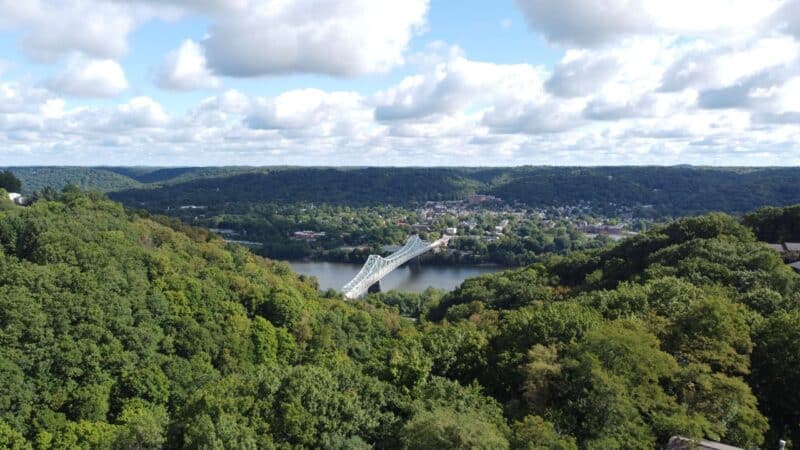
Distance from downtown: 15.6 miles
Population: 26,863 with 18% of the population over 65 years of age
Located in Allegheny County, close to Pittsburgh International Airport, and a short drive from the city, Moon Township offers a dense suburban feel. With reasonably priced housing, first-rate public services, quality schools, and a fiscally-responsible government, residents experience all the benefits of a close-knit community without breaking the bank while still having access to all urban life has to offer.
Places to visit:
- Whether you’re looking to play, hike, bike, or explore, Moon Park, Montour Trail, and Robin Hill Park are just some of the parks that combine to offer over 600 acres of land perfect for staying active through all the seasons.
3. Oakland, Shadyside, and Squirrel Hill
Cultured, laid back, and family-oriented
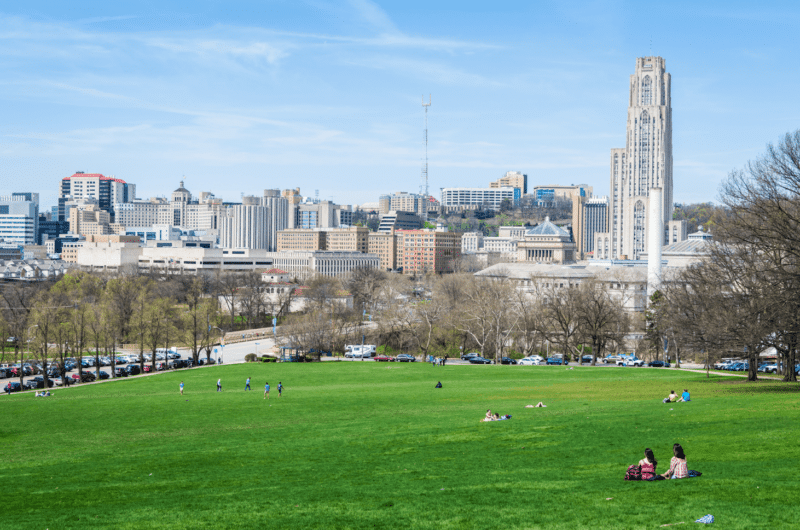
Distance from downtown: 5 minutes
Though these 3 areas fall under the most populous of the city’s 90 neighborhoods, their diverse community feel, friendly vibes, and beautiful landscape leave residents feeling welcome and relaxed. Walking distance to downtown results in convenient living, access to some of the best healthcare, and presents the opportunity to take advantage of internationally recognized educational institutions. Strolling down tree lined streets and past historic buildings, partaking in culturally diverse cuisine, exploring gorgeous public parks, and shopping in a bustling business district are just some of the attractions residents and visitors can take advantage of.
Places to visit:
- Schenley Park: Named one of “America’s Coolest City Parks” by Travel and Leisure, this 456 winding acre area contains trails, woods, and attractions. Hike or bike the miles of trails, play on one of the 13 tennis courts, run the track, or play 18 holes of golf. No matter what you’re looking for, there’s plenty to do for all ages.
- Phipps Conservatory and Botanical Gardens: This green oasis in the middle of Pittsburgh’s Oakland neighborhood has been entertaining visitors since 1893. Visit to discover breathtaking seasonal flower shows, stunning outdoor botanical gardens, and enjoy activities sure to satisfy every age.
Interesting facts:
- Roslyn Place, the last wooden street remaining in Pennsylvania, can be found in the Shadyside neighborhood. Constructed in 1914 with 26,000 wooden blocks, this road is a must-see.
4. Irwin
Rural, close-knit community
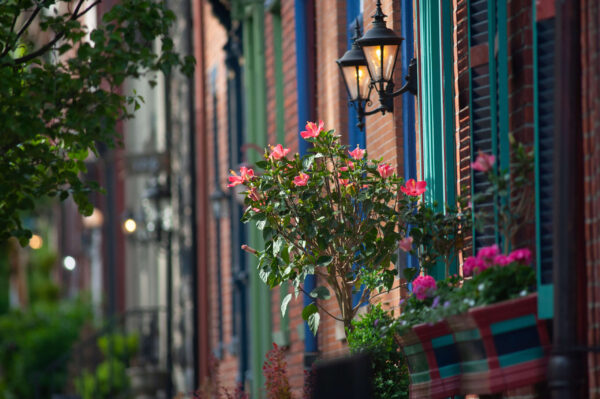
Distance from downtown: 22 miles
Population: 3,894 with 16.4% of the population over 65 years of age
Popular for its suburban community feel, Irwin is the perfect destination for anyone who wants a more relaxed and less expensive alternative to the city. Surrounded by a rich history, a proud culture, a beautiful landscape, and year round events and festivals, there is always something to do for residents and travelers alike.
Places to visit:
- Brush Hill: This historic “mansion-scale” house, also known as the “Old Scull House ” was constructed by Colonel John Irwin in 1798. One of three plantations owned by the family, its sheer scale and first of its kind west of the Appalachians, caused it to be added to the National Register of Historic Places in 1975.
- Logan Family Farms: Established in 1894 and widely recognized as the staple of quality meat and produce for four generations, this family farm is a frequent stop for residents and a must stop for visitors.
- The Lamp Theatre: Tucked in the downtown amongst a variety of restaurants and small shops sits this unique venue that offers live concerts and plays for all ages.
Though everyone’s idea of what they want out of their neighborhood and eventual retirement are different, it’s always important to consider factors in each stage of your life to make the most out of your investments and transitioning into those golden years. As you settle into and make those important decisions about your investment management, retirement planning, or any other financial needs, don’t hesitate to contact us with any questions you have. We have offices in both Downtown Pittsburgh and Eastern Pittsburgh.
Disclosures:
The views, opinions, and content presented are for informational purposes only. They are not intended to reflect a current or past recommendation; investment, legal, tax, or accounting advice of any kind; or a solicitation of an offer to buy or sell any securities or investment services. Nothing presented should be considered to be an offer to provide any product or service in any jurisdiction that would be unlawful under the securities laws of that jurisdiction. All investments involve risk, including the possible loss of some or all of the principal amount invested. Past performance of a security or financial product does not guarantee future results. Investors should consider their investment objectives, risks, and risk tolerances carefully before investing. The Firm has made every attempt to ensure the accuracy and reliability of the information provided, but it cannot be guaranteed.

Brian Werner is a Managing Partner at Winthrop Partners. He has more than 25 years of experience in investments, financial planning, entrepreneurial ventures, corporate finance, and banking. Prior to joining Winthrop Partners, Brian was the First Vice President and a Senior Wealth Advisor for First Niagara, where he led the development of First Niagara’s Western Pennsylvania Private Client Services and served on its western Pennsylvania operating committee. He also held roles with PNC/National City, Greycourt Investment Advisors, and Linnco Future Group, Chicago Board of Trade. Brian is a Chartered Financial Analyst and Certified Financial Planner. He earned his MBA from Duquesne University, Magna Cum Laude.

